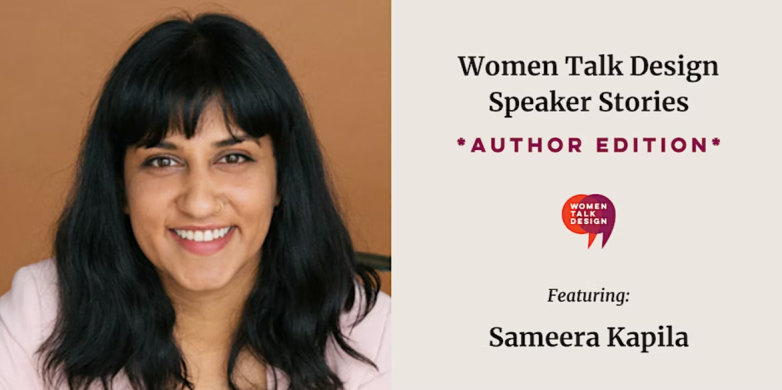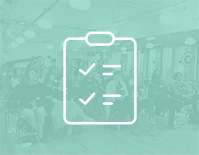Sameera Kapila on her journey from teaching to speaking to writing
As part of our #WTDSpeakerStories, we spoke with Sameera Kapila about her background in teaching and how that led her to first speaking then writing.
In our Women Talk Design Speaker Stories series, we’re interviewing Women Talk Design speakers about their journeys and experiences. We talk to speakers who are just getting started, speakers who have had their fair share of speaking mishaps, speakers writing books, and speakers curating events. At the end, we offer an opportunity for folks from the WTD community to ask their own questions and connect with each other. Visit our events page for more information about the series and RSVP for our next event.

Sameera Kapila is a designer, educator, manager, speaker and writer who works as a senior product designer at Netlify. Born in India, raised on the Dutch island of Curaçao, and currently living in Austin, TX, Sameera has held roles in agencies, educational institutions, and consultancies ranging from individual contributor to executive leadership, student to educator, and everything in between. This experience influences and powers Sameera to analyze design holistically, identifying gaps and advocating for solutions. Sameera has given talks at SXSW, CreativeMornings, Clarity, and other conferences around the US. Her new book, Inclusive Design Communities, is now available.
On how she started speaking
Sameera told us how her experience teaching led her into speaking.
“There was a meetup in Austin many, many moons ago and I met someone there who asked what I was teaching, and I told them I was teaching responsive web design. As far as we knew, this was the first university course that covered this topic, and I was kind of giving a spiel about responsive web design, and how we got it into the curriculum in a state institution that has a lot of review rounds, and they said, ‘You need to do a talk about this.’ I was like, ‘Oh, I’m not a conference speaker–I teach.’ They said, ‘It’s a different audience, but it’s kind of the same thing that you’re already doing.’ So we went down that path where I was connected with Gene Crawford, who has run a lot of different events.”
“I definitely freaked out. I had actually reached out to a few other speakers I really admired and said, ‘Do you have any advice?’ I got very long emails back. But all of them also said, ‘Just breathe. Remember to breathe.’”
She explained how her first time speaking didn’t come with the usual stage fright because she was used to standing up in front of a classroom. But it was still a new experience.
“I’ve had [so much] time in my career in the front of a classroom that I don’t think about it anymore as it’s happening–I’m just focused on a thing. The stage fright is gone. Because this is the first book, I don’t know if I can do this again. I don’t think I’ve had enough practice to say that I can, that I prefer one over the other.”
“In a classroom, I’m expecting for this to be a two-way conversation. There’s a lot of 3 hour long classes so there’s a lot of what people call ‘lab time’ or ‘studio time’. I expected a lot of that at the conference setting and to just have people not say anything back, I’m like, ‘What do I do with the silence?’ So that part was a transition for sure.”
On why she started writing
Sameera went on to highlight how she began writing through more personal exploration.
“In terms of writing, it’s been a really strange process. I’ve had so many questions along the way.”
“There’s another author named Jeremy Keith, who talks about blog posts and how your blog is your personal site. It’s your journal. Writing for yourself is the most important part. And, if it happens to benefit someone else, great–but just write down your process and the things that you’re doing. So it started there.”
For her, she said writing came about as a supplement to speaking–a way to dig deeper while also making her ideas more accessible.
“Part of [the reason I write] is that conference settings are really great [but] what tends to happen is we think, ‘I am gonna dive into this once I get home. I’m gonna read about this for a while, I’m gonna know this thing forever.’ And we get back from whether we traveled to or that zoom call ends and we forget to go back to that thing that we heard about at the conference.
“Putting it in writing makes it available for people to see and to go back to and reference. It’s really easy to just say, ‘Oh, I need this today because I’m working on information architecture so I’m gonna look at this book.”
“Another part is–and this is actually something that we talk about in the book–is access to conferences. There are a lot of different barriers. For example, sometimes the cost can be really high. It’s great to see conferences introduce pay what you want models or scholarships and other ways to get access. Having a book is a lot lower cost than a conference and it’s something you get to take home with you.”
On her experience writing a book
Sameera pointed to the conversations she was having in the classroom as inspiration for her to begin writing–she was talking about important topics before she began to write anything down.
“We’re all waiting for systems to change. But there’s stuff we can do and if we all take one task or all do the little things together, then we’re gonna push that barrier away. That’s where it started–talking about it in that lens. There were a lot of conversations with not only the instructors but the students about this sort of stuff, and what that means to enter the tech world when you’re a career changer, and the barriers to entry there.
“That it was always sort of happening in other places but I never wrote it down.”
When going over how the book came together, she talked about her own professional evolution guiding the flow of the content.
“The way that I looked [at the book]–in one of the first parts of working with Katel and the rest of the A Book Apart team, in even the process before like the proposal of the book–was thinking about that structure and what is this going to entail? That outline was almost a timeline of parts of my career.
“It was like, ‘Oh! This thing is affecting me because of this part of my identity. Other people are talking about what they’re going through and I can relate to that. That’s chapter 1 and 2 in a way.”
“Chapter 3 is getting into education. We talk a lot about being a student or being a teaching assistant, and then teaching full time. After that it goes into hiring, which is the thing I did after teaching. At that point, I was also noticing burnout in the industry so there were a lot of conversations about retention–how do we make things better? There’s a chapter that was about getting into conferences and speaking. The last chapter tells that story in between that first speaking opportunity and this book coming out.”
For Sameera, the book writing process still holds a lot of unanswered questions. But it has taught her to embrace her own voice in writing.
“I am obsessed with A Book Apart. I went through the proposal process, and I’m still in shock that they said yes. There is a lot of work that goes into different publishing processes and I’ve asked Katel 1,000 questions–even most recently as yesterday, I asked how ISBN works.”
“This is an industry that I consume from but know nothing of the work that it takes to get there. There was a lot of reading of books. There was asking other authors about what it’s like to write a book and should something be self-published versus working with an amazing team like a book apart.”
“I feel very self-conscious all the time on social media. I am full of typos. I’ve been told this by one of the editors and it’s 100% true. My second grade teacher will agree that my brain is going faster than my handwriting or my hand typing.”
“This process has taught me to embrace that. But, up until starting this process, I was convinced that it wasn’t a thing for me, that it wasn’t a thing that I would be able to do. I just didn’t think I would fit in. There were some wonderful people nudging me and here we are.”
On how her writing process differs from how she builds talks
Sameera explained that her process for both writing and for building talks can look different depending on the topic she’s discussing.
“Initially I was trying to be very [structured]–type things out and put them in order, start at the introduction and then get to the end kind of thing. It was clear pretty quickly when I started writing that that’s not gonna work.”
“What I ended up doing was, for the things that felt like I had them in order, something that was very step by step, I’d go through and say, ‘Ok, we’re now on this stage. And now we’re on this stage, etc.’ A good example of this is when I talk about hiring–it feels like I can easily work in that chronological order.”
“There were other areas where I needed to have lots of post-it notes that I was moving around and saying, ‘Does this make sense before this?’”
“We were writing in Word but I didn’t want to come up with the concept there. A lot of times, when I was adding something new, it was brought over from Notion. I just had a lot of my links stored there so it’s just easy to reference. When it felt more loose, I would hang out in Notion until I felt like it was ready to move to Word.”
“For lack of a better metaphor, I found out I needed to cook in a different way. Cooking things in the order of the recipe worked for some stuff, but in other areas, I just needed to throw everything into the instant pot.”
For more on what has surprised Sameera most about writing, how she connects with her community, and her tips for facing imposter syndrome, check out the full video below.

